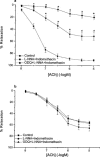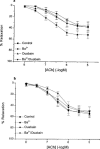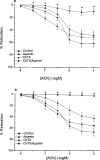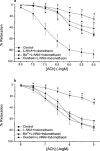Potassium- and acetylcholine-induced vasorelaxation in mice lacking endothelial nitric oxide synthase
- PMID: 10725268
- PMCID: PMC1571935
- DOI: 10.1038/sj.bjp.0703144
Potassium- and acetylcholine-induced vasorelaxation in mice lacking endothelial nitric oxide synthase
Abstract
1. The contribution of an endothelium-derived hyperpolarizing factor (EDHF) was investigated in saphenous and mesenteric arteries from endothelial nitric oxide synthase (eNOS) (-/-) and (+/+) mice. 2. Acetylcholine-induced endothelium-dependent relaxation of saphenous arteries of eNOS(-/-) was resistant to N(omega)-nitro-L-arginine (L-NNA) and indomethacin, as well as the guanylyl cyclase inhibitor, 1H-(1,2,4)oxadiazolo(4,3-a) quinoxalin-1-one(ODQ). 3. Potassium (K(+)) induced a dose-dependent vasorelaxation which was endothelium-independent and unaffected by either L-NNA or indomethacin in both saphenous and mesenteric arteries from eNOS(-/-) or (+/+) mice. 4. Thirty microM barium (Ba(2+)) and 10 microM ouabain partially blocked potassium-induced, but had no effect on acetylcholine-induced vasorelaxation in saphenous arteries. 5. Acetylcholine-induced relaxation was blocked by a combination of charybdotoxin (ChTX) and apamin which had no effect on K(+)-induced relaxation, however, iberiotoxin (IbTX) was ineffective against either acetylcholine- or K(+)-induced relaxation. 6. Thirty microM Ba(2+) partially blocked both K(+)- and acetylcholine-induced relaxation of mesenteric arteries, and K(+), but not acetylcholine-induced relaxation was totally blocked by the combination of Ba(2+) and ouabain. 7. These data indicate that acetylcholine-induced relaxation cannot be mimicked by elevating extracellular K(+) in saphenous arteries from either eNOS(-/-) or (+/+) mice, but K(+) may contribute to EDHF-mediated relaxation of mesenteric arteries.
Figures









Similar articles
-
The contribution of d-tubocurarine-sensitive and apamin-sensitive K-channels to EDHF-mediated relaxation of mesenteric arteries from eNOS-/- mice.J Cardiovasc Pharmacol. 2012 May;59(5):413-25. doi: 10.1097/FJC.0b013e318248acd9. J Cardiovasc Pharmacol. 2012. PMID: 22217882
-
Contribution of K+ channels and ouabain-sensitive mechanisms to the endothelium-dependent relaxations of horse penile small arteries.Br J Pharmacol. 1998 Apr;123(8):1609-20. doi: 10.1038/sj.bjp.0701780. Br J Pharmacol. 1998. PMID: 9605568 Free PMC article.
-
Acetylcholine-induced relaxation of peripheral arteries isolated from mice lacking endothelial nitric oxide synthase.Br J Pharmacol. 1999 Oct;128(3):653-8. doi: 10.1038/sj.bjp.0702858. Br J Pharmacol. 1999. PMID: 10516645 Free PMC article.
-
Novel endothelium-derived relaxing factors. Identification of factors and cellular targets.J Pharmacol Toxicol Methods. 2000 Sep-Oct;44(2):441-52. doi: 10.1016/s1056-8719(00)00127-1. J Pharmacol Toxicol Methods. 2000. PMID: 11325586 Review.
-
Endothelium-derived hyperpolarizing factor.Blood Vessels. 1990;27(2-5):238-45. doi: 10.1159/000158815. Blood Vessels. 1990. PMID: 2242444 Review.
Cited by
-
Luteolin-induced vasorelaxation in uterine arteries from normal pregnant rats.Pregnancy Hypertens. 2021 Mar;23:11-17. doi: 10.1016/j.preghy.2020.10.008. Epub 2020 Oct 23. Pregnancy Hypertens. 2021. PMID: 33161224 Free PMC article.
-
TRPV4-mediated endothelial Ca2+ influx and vasodilation in response to shear stress.Am J Physiol Heart Circ Physiol. 2010 Feb;298(2):H466-76. doi: 10.1152/ajpheart.00854.2009. Epub 2009 Dec 4. Am J Physiol Heart Circ Physiol. 2010. PMID: 19966050 Free PMC article.
-
Neuronal nitric oxide synthase (NOS) regulates leukocyte-endothelial cell interactions in endothelial NOS deficient mice.Br J Pharmacol. 2001 Sep;134(2):305-12. doi: 10.1038/sj.bjp.0704234. Br J Pharmacol. 2001. PMID: 11564648 Free PMC article.
-
Calcium-activated potassium channels and endothelial dysfunction: therapeutic options?Br J Pharmacol. 2009 Feb;156(4):545-62. doi: 10.1111/j.1476-5381.2009.00052.x. Epub 2009 Jan 29. Br J Pharmacol. 2009. PMID: 19187341 Free PMC article. Review.
-
Interaction between nitric oxide signaling and gap junctions: effects on vascular function.Biochim Biophys Acta. 2012 Aug;1818(8):1895-902. doi: 10.1016/j.bbamem.2011.07.031. Epub 2011 Jul 28. Biochim Biophys Acta. 2012. PMID: 21835160 Free PMC article. Review.
References
-
- ADEAGBO A.S., TRIGGLE C.R. Varying extracellular [K+]: a functional approach to separating EDHF- and EDNO-related mechanisms in perfused rat mesenteric arterial bed. J. Cardiovasc. Pharmacol. 1993;21:423–429. - PubMed
-
- CHEN G., CHEUNG D.W. Effect of K(+)-channel blockers on ACh-induced hyperpolarization and relaxation in mesenteric arteries. Am. J. Physiol. 1997;272:H2306–H2312. - PubMed
-
- COOK N.S. In Potassium channels: structure, classification, function and therapeutic potential 1990Halsted Press: New York; 181–325.(ed)
-
- DOUGHTY J.M., PLANE F., LANGTON P.D. Charybdotoxin and apamin block EDHF in rat mesenteric artery if selectively applied to the endothelium. Am. J. Physiol. 1999;276:H1107–H1112. - PubMed
Publication types
MeSH terms
Substances
LinkOut - more resources
Full Text Sources
Medical

